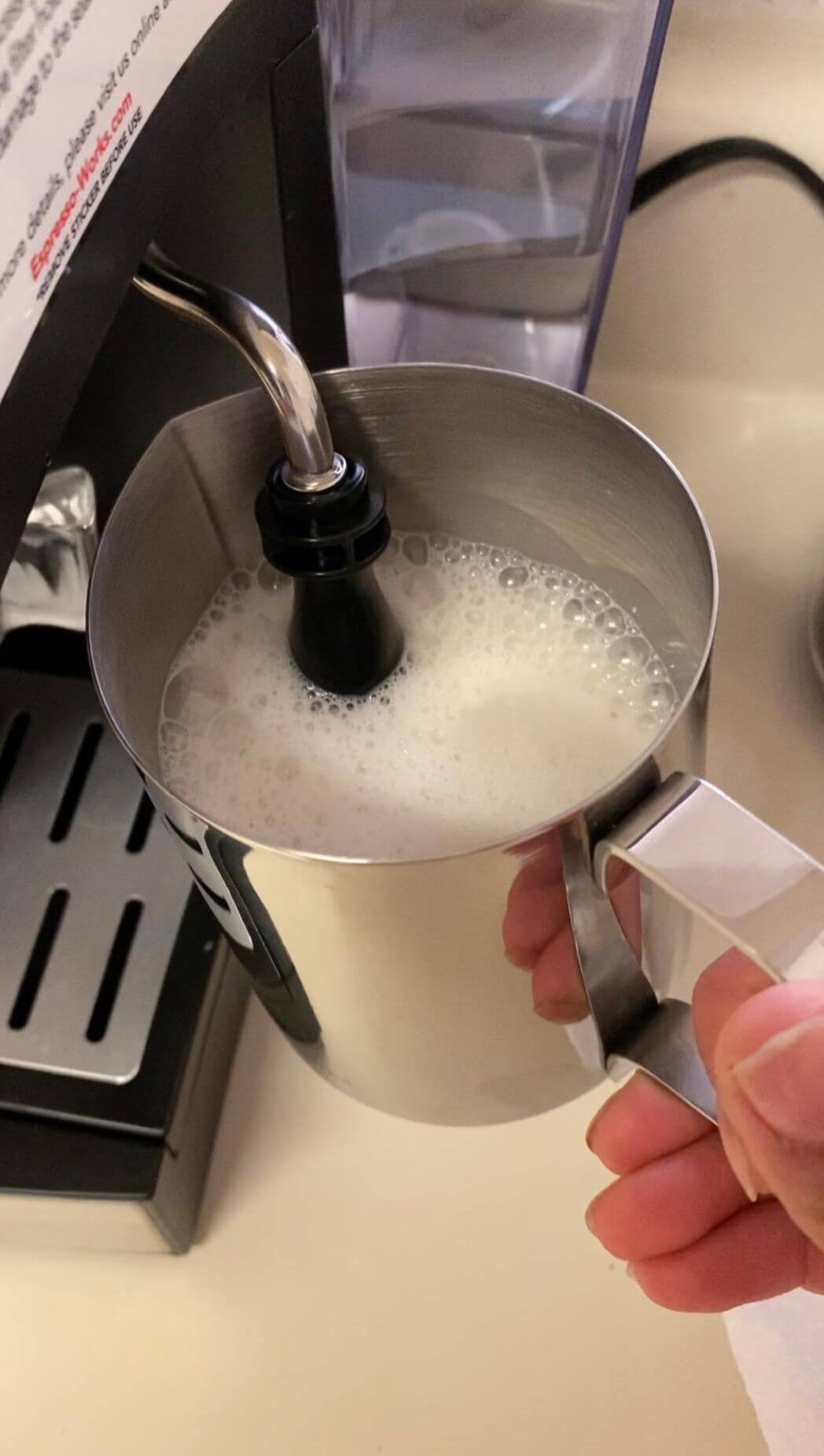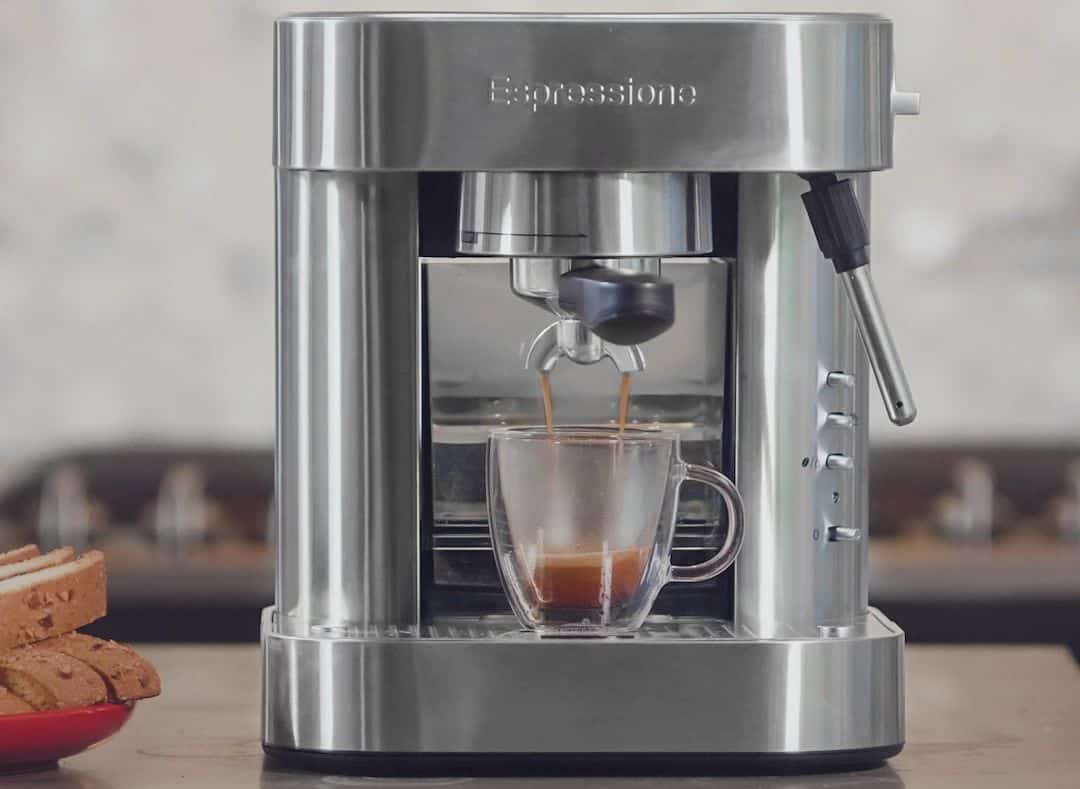5 Espresso Machines With Grinders For That Strong Aroma And Taste. A coffee grinder is a must if you want the perfect coffee every single time. When the coffee grounds are powdered, either coarsely or roughly, it lends a distinct taste to your coffee. Coffee that is made from well-ground coffee beans is more robust, rich, aromatic and has a smoother taste.
If you are looking for a way to enjoy your coffee, latte, or cappuccino from the comfort of your home, then an espresso machine with a grinder is what you need. However, choosing a perfect espresso machine is not as simple as brewing a cup of coffee.
Coffee beans are brewed within minutes of grinding in these coffee machines while bringing a fantastic blended flavour. The only drawback of the coffee maker machines is that they are slightly expensive. But considering the flavour and quality of the coffee, buying one is worth it. This guide has picked some of the coffee machine grinders for you.
In this article, you will find five espresso machines with grinders. That’s not all; we will also show you all you need to know about espresso machines and the factors you should consider when choosing an espresso machine for yourself.
-
1.
5 Espresso Makers with Grinders For Pure Espresso Lovers
- 1.1. 1. Breville BES870XL Barista Express Espresso Machine
- 1.2. 2. De’Longhi ESAM3300 Magnifica Super Automatic Espresso & Coffee Machine
- 1.3. 3. Gaggia Brera Super Automatic Espresso Machine
- 1.4. 4. Gaggia 1003380 Accademia Espresso Machine
- 1.5. 5. EspressoWorks All-In-One Espresso Machine & Cappuccino Maker
- 2. Buying Guide for Espresso Machines with Grinder
- 3. Types of Espresso Machines
- 4. What Are The Three Main Categories Of Espresso Machines?
- 5. Steam-Powered Espresso Machine
- 6. Type of Coffee for an Espresso Machine
- 7. What Are The Grinder Types In Espresso Makers?
- 8. Which Grinder Type to Buy For Your Espresso Machines?
- 9. What To Take Into Consideration When Choosing An Espresso Machine?
- 10. Single Boiler System – How it Works?
- 11. Dual Boiler System – How it Works?
- 12. Heat Exchanger (HX) – What it is, and How it Works?
- 13. When Should You Choose One Over the Other?
- 14. Why Should You Froth Your Milk?
- 15. Can You Buy a Milk Frother Separately?
- 16. FAQ
- 17. Final Words
5 Espresso Makers with Grinders For Pure Espresso Lovers
1. Breville BES870XL Barista Express Espresso Machine
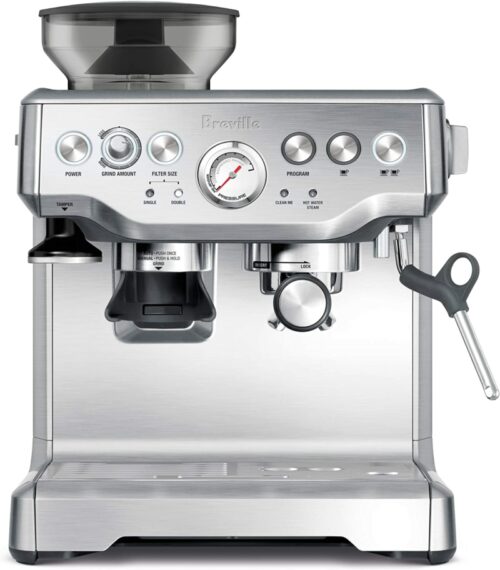
This semi-automatic espresso machine features a built-in, conical burr grinder that is durable and easy to maintain and has a quiet operation. Even more, it has a grind-size dial with 18 grind settings that allow you to adjust the bean’s fineness or coarseness level to suit your taste.
Thanks to its digital temperature control setting, the machine delivers water between 195 to 205°F, optimal for espresso extraction. It has a steam wand that allows you to hand texture micro-foam milk to enhance flavour and smooth latte art creation.
One stand-out feature of this product is its low-pressure pre-infusion system that gradually increases pressure from the start-up to 15 bars for even extraction and rich flavour. Additionally, it allows the beans to absorb water uniformly during the brewing process to prevent channelling.
The Breville BES870XL coffee maker comes with a removable 67oz plastic water tank at the back of the machine. It allows you to prepare 16 cups of espresso before requiring refilling. There’s also a replaceable water filter located inside the tank that helps to purify the water and remove both fine and coarse particles.
This coffee maker with grinder comes with an automatic off feature that turns off the unit after 3 hours of inactivity. It has a hot water dispenser for instant hot water to make tea and long blacks faster than electric heaters and kettles.
It is worth mentioning that this unit allows you to make six different coffee types: Espresso, Cappuccino, Latte, Flat white, Americano, and Macchiato. There’s also an automatic dosing feature that dispenses the required amount of coffee for either a single or double cup dose.
Pros
- It is easy to clean
- Superb build quality
- It allows you to brew up to six coffee types
- It can serve as a water dispenser
- Suitable for both novices and professionals
Cons
- You can not brew and steam simultaneously
- Some users complained about its small-sized portafilters.
Specifications
| Type | Semi-automatic |
| Dimensions | 12.5 x 12.6 x 13.1 inches |
| Water reservoir | 67 oz |
| Bean hopper | 8 oz |
| Grinder type | Conical burr grinder |
| Pressure | 15-bar |
2. De’Longhi ESAM3300 Magnifica Super Automatic Espresso & Coffee Machine
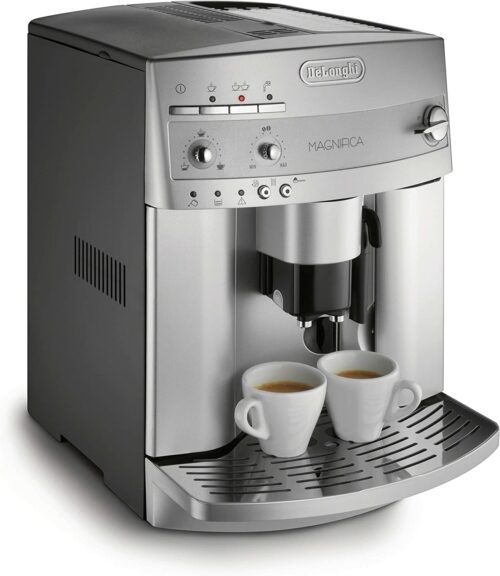
The DeLonghi Magnifica ESAM 3300 is an elegant super-automatic espresso machine with a grinder. It comes with a silver-coloured plastic exterior and won’t disappoint you when it comes to functionality.
This unit comes with an 8.8oz bean and a 60-ounce removable water reservoir that is enough to make up to 14 cups of coffee and espresso. Not just that, it also has indicator lights that notify when to refill the hopper and water tank.
If you want to enjoy your favourite café style of espresso, then you will love this machine’s conical burr grinder. It is not only quiet but also allows you to choose a fineness or coarseness level to suit your taste, thanks to its 13 grind levels. On the other hand, you can use its pre-ground coffee basket if you are in a hurry or out of coffee beans.
One of the features we love is the dual boiler system that allows you to make cappuccino and espresso in a short brew time. Its 15-bar pump pressure also helps in ensuring maximum flavour extraction in a short period.
This espresso machine comes with a cup warmer that helps to keep your cup or mug warm. It is also easy to clean, thanks to its decalcification feature that notifies you on when to clean it from limescale build-up while the automatic rinse program cleans the coffee spout after use.
Additionally, it has a removable drip tray with a level indicator to know when to empty and clean it. One feature you will also love is the automatic shut-off system that turns off the unit after 3 hours of inactivity.
Pros
- You can simultaneously brew two espresso cups
- It is easy to clean thanks to removable parts that are dishwasher-safe
- You can brew and steam at the same time
- It has a compact design to fit into any space
- You can brew rich and tasty espresso, cappuccino, and latte
Cons
- Some users complained that the grinder gets stuck occasionally.
- The grinder is a bit noisy.
Specifications
| Type | Super-automatic |
| Dimensions | 11 x 15.3 x 14.4 inches |
| Water reservoir | 60 oz |
| Bean hopper | 8.8 oz |
| Grinder type | Conical burr grinder |
| Pressure | 15-bar |
3. Gaggia Brera Super Automatic Espresso Machine

The Gaggia Brera Espresso machine with a built-in grinder is a super-automatic machine with an LCD screen and a control panel with four buttons to customize your choice of drink and perform essential and custom functions. This coffee has a ceramic burr grinder with five grind settings that give you high-level control of the grind size and uniform grinding.
The product features an 8.8 oz airtight bean hopper to keep the beans fresh and a 40oz water reservoir that can make up to 8 espresso cups before refilling. It also features Optiaroma technology with three strength options that allow you to choose between three light, medium, and strong brews.
The product has a pre-infusion feature that starts saturation at a lower pressure before slowly increasing to the standard 15-bar amount for espresso brewing. You will love its Pinarello wand that lets you froth lattes and cappuccinos while also doubling as a hot water dispenser for making tea and americanos.
This espresso maker with grinder comes with a rapid steam technology that heats up to steam temperature in less than 10 seconds to reduce steaming and brewing time. It also uses an algorithmic learning system to self-adjust grinding speed and time based on your coffee and strength setting.
Furthermore, it is easy to clean and maintain thanks to its removable brew group, drip tray, water tank, and auto rinse feature that automatically flushes the machine after use. Even more, it has an auto-off feature that turns off the equipment after one hour of inactivity.
Pros
- It notifies you of when to describe
- Compact construction to fit into tight spaces and kitchens
- Self-adjust grinding speed and time depending on bean type
- The drip tray requires frequent emptying
- It is easy to clean thanks to its removable parts
Cons
- Some users complained that the machine is a bit noisy
- You need to refill the water tank frequently
Specifications
| Type | Super-automatic |
| Dimensions | 10 x 15.5 x 11.5 inches |
| Water reservoir | 40 oz |
| Bean hopper | 8.8 oz |
| Grinder type | Ceramic burr grinder |
| Pressure | 15 -bar |
4. Gaggia 1003380 Accademia Espresso Machine
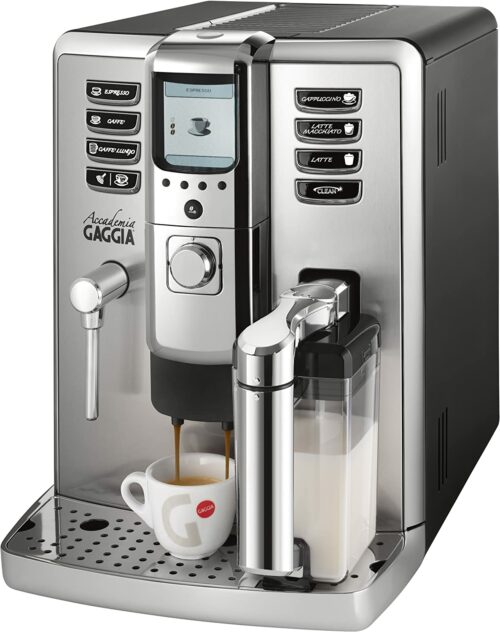
The Gaggia 1003380 Accademia features an interactive display that allows you to configure brewing options and settings for easier coffee customization. It comes with a digital display and 8 buttons for selecting its 7 preloaded brewing choices, including Caffe lungo, espresso, cappuccino, macchiato, americano, latte, and coffee.
This super-automatic coffee machine with a grinder has a detachable milk container that allows you to store the milk in a refrigerator when not in use. Another great feature of this Gaggia espresso maker is that you can adjust your coffee’s brew temperature, milk quantity, and brew length before and during brewing to suit your taste.
The product comes with a 54 oz water tank that can make up to 8 espresso cups before refilling. It features an adjustable coffee dispenser that can accommodate cups of different sizes between 3 to 6 inches.
We also loved its ceramic burr grinder with 8 grinder settings that allow you to choose a suitable fineness or coarseness level. The unit features 3 strength settings that let you choose between light, medium, and strong brews.
Furthermore, this espresso maker comes with both an auto-frothing milk carafe and a manual frothing wand. While the auto-frothing wand allows you to make a milk-based brew with the touch of a button, the manual frothing wand lets you choose how foamy you want your milk, ranging from an airy to a microfoam.
It is also worth mentioning that this unit is easy to clean thanks to its detachable brew group and automatic cleaning cycle that rinses the milk circuit after each use to ensure it is free of contaminants and clogs.
Pros
- It gives you plenty of customization options
- One-touch operation for easy usage
- It supports both coffee grounds and whole beans
- It offers several preset options
- Has a timer for brewing times
Cons
- The drip tray requires frequent emptying
Specifications
| Type | Super-automatic |
| Dimensions | 11 x 16 x 14.6 inches |
| Water reservoir | 54 oz |
| Bean hopper | 12 oz |
| Grinder type | Ceramic burr grinder |
| Pressure | 15-bar |
5. EspressoWorks All-In-One Espresso Machine & Cappuccino Maker
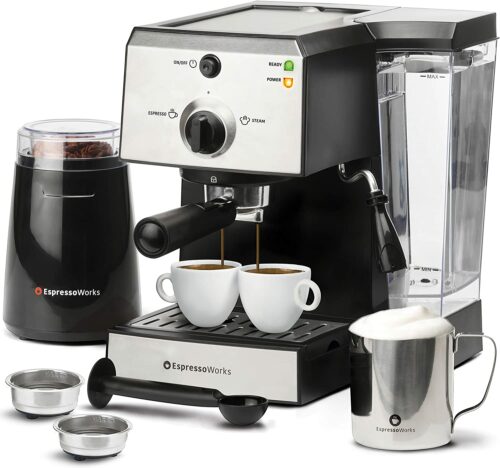
EspressoWorks is a 7-in-1 piece of equipment consisting of an espresso maker, milk frother, grinder, frothing cup, measuring spoon, portafilter, and two cups. It features an electric blade grinder that grinds quickly and is also suitable for grinding flavoured coffees.
Although the ideal pressure for espresso is 9 bars, this product comes with a 15-bar pressure system that allows you to brew macchiato, cappuccinos, americano, and lattes. It also features a dual portafilter basket that helps you choose between a single or double shot.
This espresso coffee machine with a grinder comes with a 42 oz transparent water tank that can make up to 8 espresso cups before refilling. That’s not all; the water tank also features a calibrated scale and built-in handles for monitoring its water level and quick removal, respectively.
The unit comes with a thermoblock that gets the machine ready in less than 45 seconds. It has LED indicators to let you know when the espresso maker is ready to brew, while its heating tray helps to keep your cup warm.
Cleaning this espresso maker is hassle-free thanks to its removable drip tray and detachable frothing device. It also features an automatic shut-off safety system that automatically turns off the machine after about 25 minutes of inactivity.
Pros
- It allows you to pull single and double espresso shots
- Brews professional-style espresso drinks
- It features a complete set of accessories for a great user experience
- The machines heat up quickly
- The heating tray keeps the cup warm
Cons
- Some users complained about the grind consistency of the grinder
- It does not support the use of coffee grounds
Specifications
| Type | Semi-automatic |
| Dimensions | 9.75 x 9 x 11.5 inches |
| Water reservoir | 42 oz |
| Bean hopper | 8 oz |
| Grinder type | Electric grinder |
| Pressure | 15-bar |
Buying Guide for Espresso Machines with Grinder
Espresso enthusiasts and beginners often face the challenge of choosing the right espresso machine. There’s been an increase in the number of espresso machine brands and manufacturers, which has made choosing the perfect espresso machine with a grinder a bit tasking.
This section will show you all you need to know about different types of espresso machines, types of coffee for espresso machines, grinder types in espresso makers, and factors to consider when choosing an espresso machine.
Types of Espresso Machines
Like every other piece of electronics, there are different types of espresso machines available in the market. One key factor differentiating these machines is their pressure-producing mechanism which is a critical factor in brewing espresso.
What is a Pump Espresso Machine?
Pump espresso machines are those that utilize a pump to push pre-heated water directly to the brewing chamber and coffee bed at the correct temperature. This machine features separate systems for controlling water temperature and generating the needed pressure to push the water.
Pump-Driven Espresso Machine
An electric pump generates pressure that extracts coffee with rich and thick crema in a pump-driven espresso machine. Additionally, the heating system of the pump espresso machine can reach higher temperatures to allow the steam wand to froth milk.
Pump-driven espresso machines are divided into three main categories: semi-automatic, automatic, and super-automatic.
What Are The Three Main Categories Of Espresso Machines?
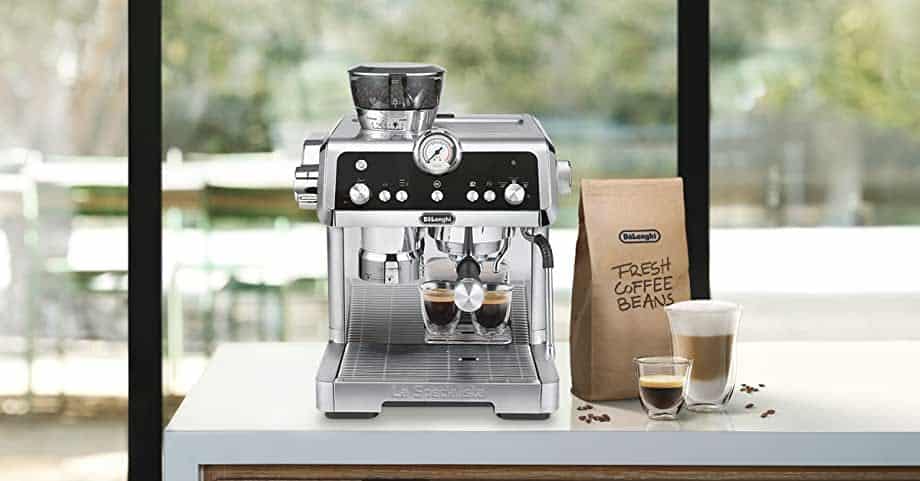
1. Semi-Automatic Espresso Machine
This espresso machine is equipped with an electric pump and is easy to use as it gives you control of the coffee brewing process with just a little effort. It allows you to handle the grinding and tapping of the coffee beans while the motor handles the pressure and flow of water.
That said, this machine gives you control of the extraction process, thereby allowing you to determine the quantity of coffee by stopping the extraction process. Several semi-automatic machines come with a steam wand for heating and frothing milk, while others have a built-in grinder.
It is worth noting that most of the semi-automatic espresso machines’ operation is automatic, so you can brew and do other activities simultaneously. It is more affordable, majorly found in commercial settings, and features multiple group heads for making several shots.
2. Automatic Espresso Machine
This machine is similar to the semi-automatic espresso machine since you need to grind and tamp the coffee beans. However, this machine determines the amount of water needed to brew your coffee. It supports a one-touch operation, which means with the touch of a button, the espresso maker will make your coffee, whether it is a latte, latte macchiato, or espresso.
Even more, some machines allow you to customize features like temperature, espresso strength, and grind size. Other brands also provide milk options for frothing and adding milk to your espresso. One downside of this machine is that it is often pricey and bulky, thereby taking up plenty of space in your kitchen.
3. Super Automatic Espresso Machine
This type of machine handles the entire brewing process from grinding, tamping, and brewing itself. It is commonly referred to as an all-in-one machine and supports one-touch operation.
The super-automatic espresso machine with grinder is easy to use, comes with a self-cleaning feature, and makes not only espresso shots. Although this machine is costlier than the automatic and semi-automatic espresso machines, it is suitable for beginners and coffee professionals.
Steam-Powered Espresso Machine
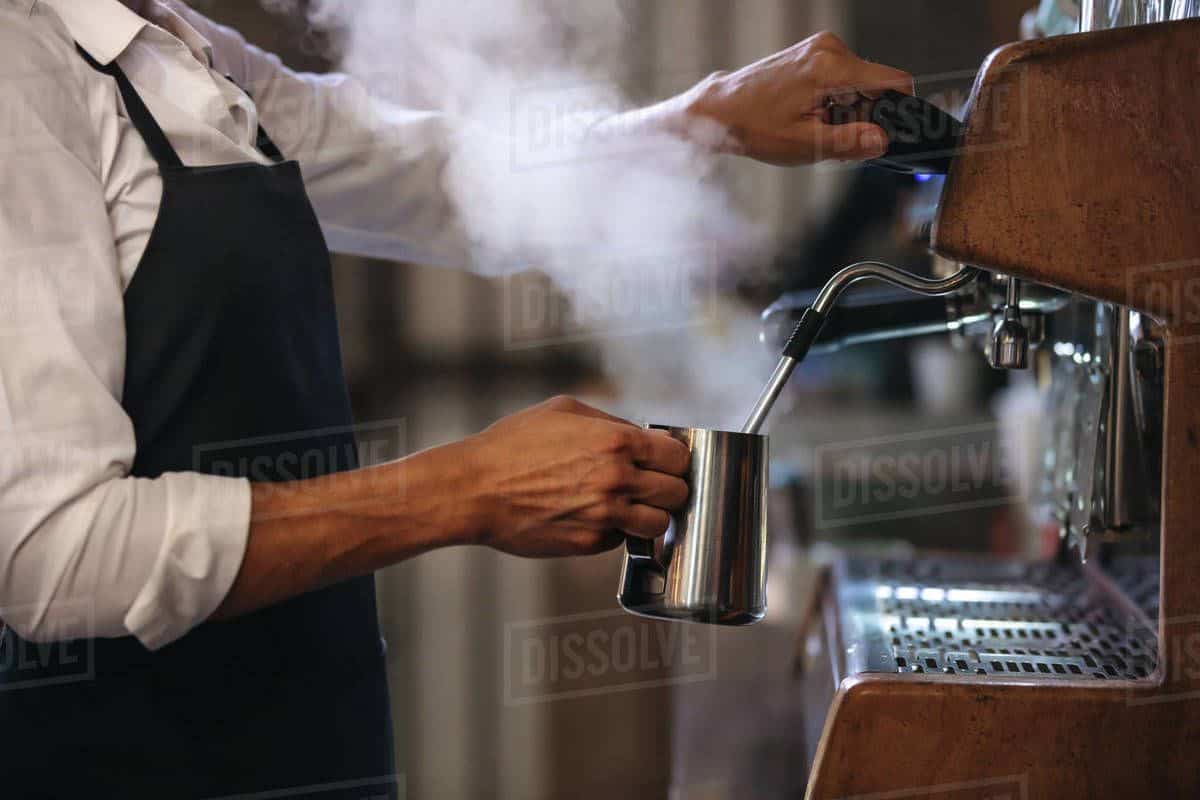
Steam-powered machines work by boiling water to create steam. The steam heats the coffee grounds to produce your favourite cup of espresso.
The machine heats water in a manually filled tank near boiling to create steam in the internal chamber. Afterwards, the steam generated is forcefully passed through the coffee beans and comes out as espresso from the portafilter.
Steam vs. Pump Espresso
Steam espresso is made when the steam generated from boiling water passes through coffee grounds. On the other hand, pump espresso is made when a pump injects pressure to push water through the coffee grounds.
The pressure from pump espresso machines is more constant than that of steam machines, ensuring that the espresso is not bitter. Also, unlike pump machines, you need to wait for it to cool down before making another cup of coffee with steam espresso machines.
Additionally, pump machines are often more expensive than steam machines, but steam espresso machines let you make espresso crema.
Espresso Pump Machines
Espresso pump machines come with different types of pumps, depending on the brand. The pumps include geared, rotating, and vibrating pumps. While vibrating pumps are commonly used in super-automatic machines due to their instability to control pressure fully, geared or rotating pumps are used in other professional-grade espresso makers.
That said, professional-grade espresso machines feature three-way release valves that allow you to pull multiple shots in quick succession.
Lever Espresso Machine
A lever espresso machine requires you to exert physical effort to brew a shot of espresso. It can either be spring-loaded or manual type.
The lever espresso machine gives you total control of the brewing process. So, suppose a particular coffee requires a specific pressure level to extract maximum flavor or requires a more extended pre-infusion period. In that case, this espresso maker will come in handy.
Not only that, this type of coffee maker does not make use of electrical components and is quite attractive. Albeit, it is not commonly in use today and is not ideal for those with busy schedules.
Type of Coffee for an Espresso Machine
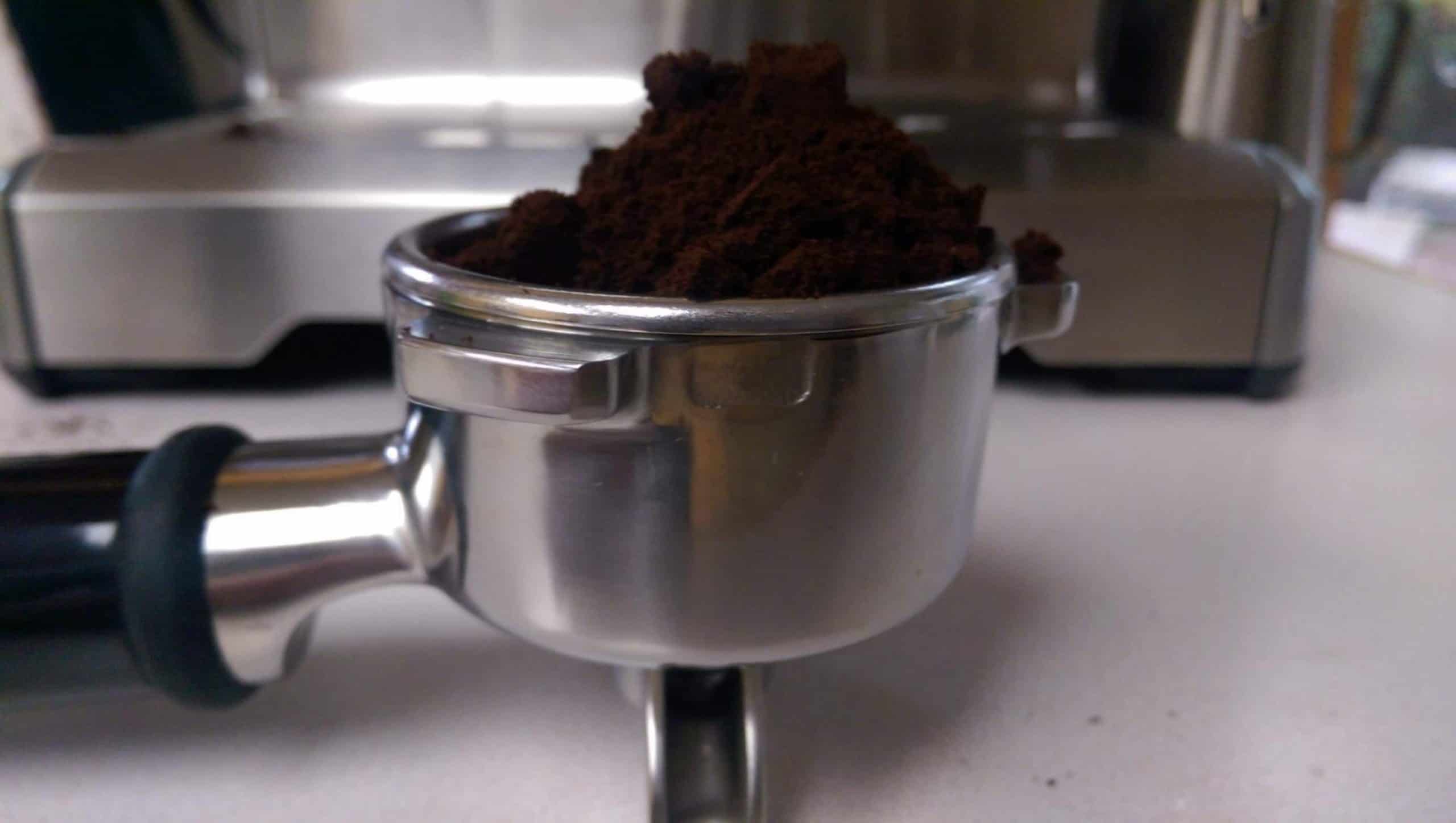
Espresso is simply a style of coffee that is strong and previously enjoyed at coffee shops. However, espresso lovers can now enjoy a shot from the comfort of their homes thanks to espresso machines.
You may likely be wondering which type of coffee is ideal for making espresso. Hence, we recommend paying attention to the proper roast, grind size, and type of coffee to get the results.
Coffee Grind Size
Espresso is made using finely ground beans. If the coffee is very coarse, water won’t quickly flow through it, resulting in a poorly extracted cup of espresso.
Although espresso needs finely ground coffee, it should retain some form of coarseness. It will help prevent the water from being blocked due to oversoaking since it is brewed under high pressure.
What Are The Coffee Beans Used In Espresso Makers?
Typically, espresso is brewed using dark roasted beans because they contain the most natural oils and are the least acidic. The richness in natural oils, and other aspects of dark roasts, help bring about that thick golden crema we all expect from a perfect espresso shot.
What Are The Grinder Types In Espresso Makers?
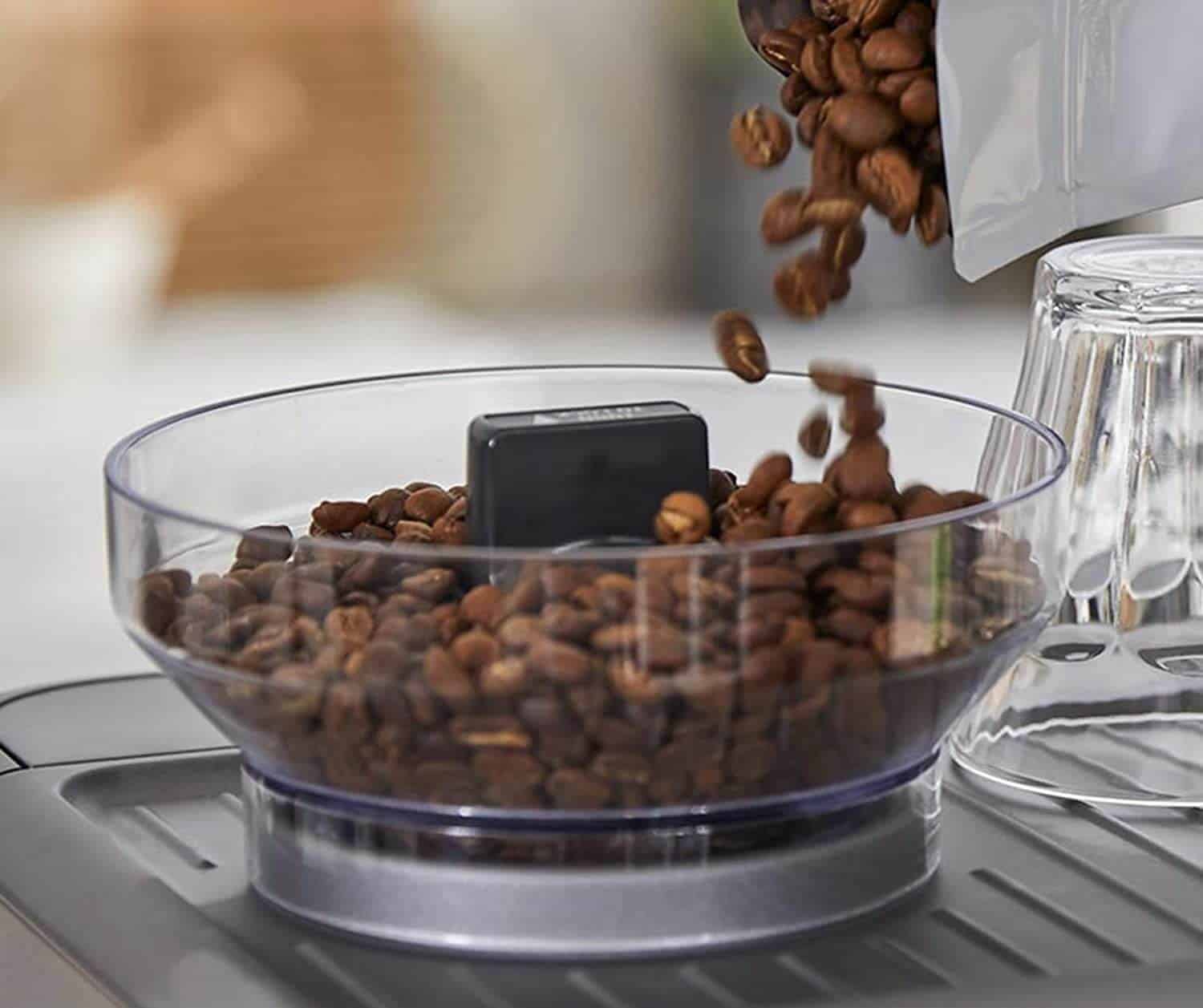
Espresso requires a fine and consistent grind to ensure optimum flavour extraction and taste. If you always want to enjoy your favourite shot of espresso, ensure your coffee beans have the right fineness texture. Hence the need for a grinder that can achieve the required fineness level.
1. Blade Grinder
This grinder comes with a blade that rotates to chop the coffee beans to different fineness and coarseness levels. Blade grinders are cheap and don’t achieve consistency as they leave some beans finely ground while others coarsely ground.
2. Burr Grinder
This type of grinder comes with double burrs, one of which is stationary while the other is rotating. The burr crushes the coffee beans into your desired fineness or coarseness level. Although this grinder type is more consistent, you may occasionally find some pieces of large beans.
3. Flat Burr Grinder
This type of grinder uses the principle of centrifugal force to push the beans directly inside the teeth of the burr. The further the beans get to the burr, the finer the grounds. The wider the burrs are, the coarser the grounds, and vice versa.
4. Conical Burr Grinder
This type of grinder features a stationary cylinder-shaped burr and a rotating cone-shaped butt inside the cylinder. With this grinder, the beans are pushed using gravity through the blades. As the beans pass through the blades, it gets finer.
Which Grinder Type to Buy For Your Espresso Machines?
Generally, burr grinders grind beans to a uniform, consistent size to make a better cup of espresso. However, conical burr grinders are more advantageous than other types of grinders.
Conical burr grinders feature a design that makes them easy to clean and require less adjustment. Even more, they have less noise and are less prone to clogging and overheating of ground.
Here is our opinion on which grinder to buy for your espresso maker.
Should You Consider Buying a Separate Grinder For Your Espresso Makers?
While some espresso machines come with built-in grinders, others do not. So, a separate grinder will come in handy if your espresso maker does not have a grinder. Similarly, if your machine’s grinder does not give you the option of customizing grind settings, you can also purchase a separate grinder.
What To Take Into Consideration When Choosing An Espresso Machine?
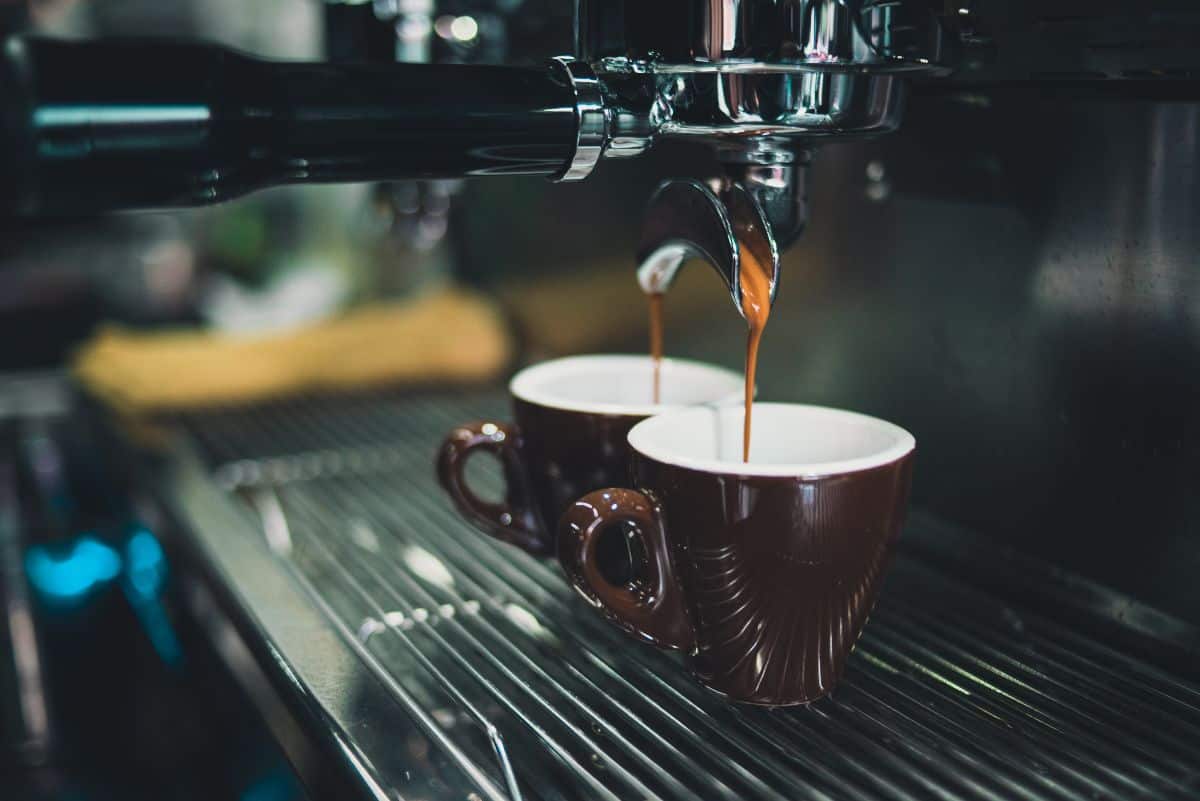
Thanks to several innovations in the espresso maker market, there are now many brands and manufacturers of espresso machines. As a result, choosing the espresso machine can be tricky as it comes with different features, shapes, and sizes.
Albeit, before deciding on the machine to buy, we recommend you consider the factors below to guarantee you make the right buying decision.
Temperature and Pressure Control
The temperature and pressure of water are critical factors in the coffee extraction and brewing process. They not only determine how effective the extraction of flavour is, but they also determine the strength of the espresso. Consequently, it is essential to ensure its stability, adjustability, and ease of use.
Thermostat / Pressure Switch
In simple terms, this switch is an adjustable analogue control system that allows you to choose a temperature level that suits you. Although you will need some practice to get used to its non-calibrated scale, you won’t need to worry if you want only to enjoy coffee or espresso with milk.
Digital PID Temperature Controller
This device helps to control the machine’s heater so that the selected temperature is maintained. This digital controller not only allows you to choose a suitable temperature with an accuracy of about 0.1 degrees, but it also ensures that the temperature is stable and saves electricity since it works in a short time, unlike an analogue temperature controller.
Thermal Insulation of Boilers
Thermal insulation of boilers uses mineral wool fibre or ceramic to protect the boiler from heating its air compartment. The insulation materials are available in both boards and rolls and can be strapped or pinned to the boiler casing.
Even more, it helps to increase the boiler’s efficiency and reduce heat losses. This insulation further improves temperature stability and reduces electricity consumption.
Single Boiler System – How it Works?
A single boiler system uses one boiler to generate steam for milk frothing and heating water for espresso. Espresso makers that feature such types of boilers are often cheaper and feature a simple design.
The downside of this boiler is that it extends brewing time for beverages like latte, flat white, and cappuccino. Also, they have low efficiency due to their low capacity.
Dual Boiler System – How it Works?
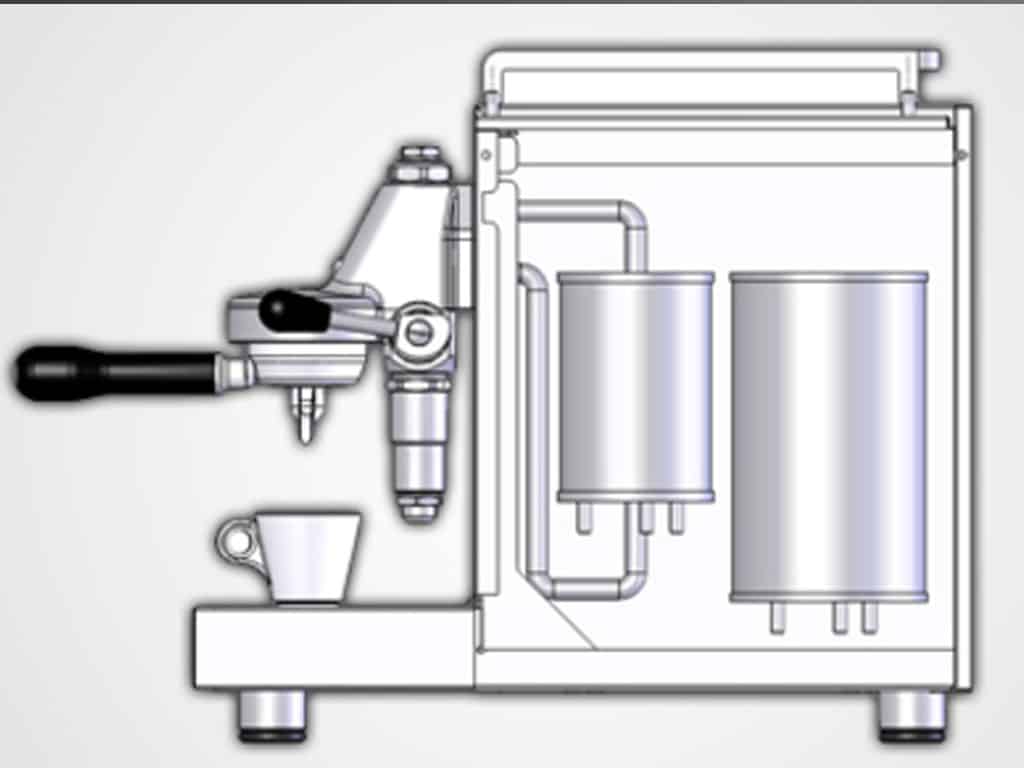
This system features double boilers, each with a separate heater. While one of the boilers is responsible for heating water, the other provides steam for frothing milk. One of the exciting features of the double boiler system is that they both work independently and provide plenty of customization options.
Heat Exchanger (HX) – What it is, and How it Works?

This boiler features a small and large boiler responsible for the heat and steam required to brew espresso. The surrounding water’s warmth heats the small boiler and, in turn, serves as a heat exchanger for brewing espresso.
One advantage of this boiler is that it allows you to brew and froth milk simultaneously. Not just that, unlike a single boiler, steam is always available with this type, and you wouldn’t need first to heat the boiler. On the other hand, the large boiler generates the required steam for frothing milk.
Additionally, although the heat exchanger is large, it has improved temperature stability and higher efficiency.
When Should You Choose One Over the Other?
If you wonder when to choose one type of boiler over the other, this section will help you make the right choice. Each type of boiler meets a specific need depending on your preference.
1. Single Boiler
Machines with single boilers are suitable for those working with a tight budget since they are relatively cheap. They are also great for those who prefer to drink black coffee and will make a great buy.
2. Heat Exchanger (HX)
If you love high-quality espresso, then the heat exchanger is the right option to choose. What’s more, the HX allows you to also froth milk to enjoy other drinks like flat white coffees and cappuccinos.
3. Dual Boiler
You should consider this type of boiler if you are looking for a boiler that can run for an extended period and brew multiple cups of beverages simultaneously. Even more, this boiler is ideal for those who want to have control of the temperature of hot water and brewing water.
4. Steam Wand – For Milk Frothing
Although most espresso makers come with this feature, this feature is a must-have if you love taking drinks with steamed milk. Generally, the costlier the machine, the better its milk-frothing mechanism.
You should consider a steam wand that has a removable tip for easier cleaning. It is also worth mentioning that espresso machines with dual boilers or heat exchangers allow you to froth milk better and faster than those with single boilers.
Why Should You Froth Your Milk?
Milk frothing helps to add air bubbles to the milk until it foams. It helps to give the milk a particular texture and adds an airy and creamy feel to the mouth.
That said, foam is an essential ingredient in making cappuccinos and adds texture and complexity to iced or cold drinks.
Can You Buy a Milk Frother Separately?
Yes, you can. There are several easy-to-use and affordable milk frothers available today. While some are handheld for whisking air into the milk, others operate with the push of a button to froth and heat milk.
Should You Buy It Separately?
Buying a separate milk frother does not only save money; it also saves time as it allows you to enjoy your favourite espresso or coffee from your home.
If you love to enjoy a foamy treat, creamy cafe latte, frothy cappuccino, or cafe-style Italian coffee, then you should buy a milk frother.
Pump – What to Look For
The pump is responsible for controlling water pressure during the espresso extraction process. Before choosing a pump type, here are things to consider.
Possible to Change Pump Settings
The quality of espresso significantly depends on water pressure during the extraction process. As a result, choosing a pump that gives you control over its settings is necessary to determine your espresso’s taste and flavour.
Vibration Pump vs. Rotary Pump
Vibration pumps are compact and affordable pumps that deliver water at a slow flow rate, making them ideal for espresso machines not require plumbing the espresso maker into mains water.
On the other hand, rotary pumps are robust, quieter, have longer lifespans, and offer better pressure consistency. They are suitable for those who want to plumb their machine into water mains.
Brewing Group
The brew group, also known as the brew head of an espresso machine, is where the extraction of coffee and espresso takes place. It is the section where you attach the portafilter when brewing espresso.
Go for 58mm as it offers more compatibility.
The size of the brew group is one of the critical factors to consider before purchasing a brew head. You should consider purchasing an espresso maker with a 58mm brew group because it is compatible with replaceable accessories like tampers and precision sleeves.
More so, 58mm in diameter is the widely used standard in both commercial and professional machines. It also helps to improve the quality of your espresso.
Water Connection
Although not all coffee makers with grinders can connect to the water supply, they offer several benefits. It is worth mentioning that espresso machines with rotary pumps support water connections. This feature allows you to connect your espresso maker to the water mains.
Water connection lets you connect your espresso maker directly to the drain and filtered water; thus, you wouldn’t need to worry about your espresso extraction due to the lack of water in the reservoir.
As a rule of thumb, most high-end espresso machines with grinders come with this feature and are suitable for home use and use in the office and small coffee shops.
Furthermore, plumbing your espresso machine helps to improve pre-infusion. More importantly, it comes in handy if you use your machine as a hot water dispenser.
How To Buy A Perfect Milk Reservoir For Your Espresso Machines?
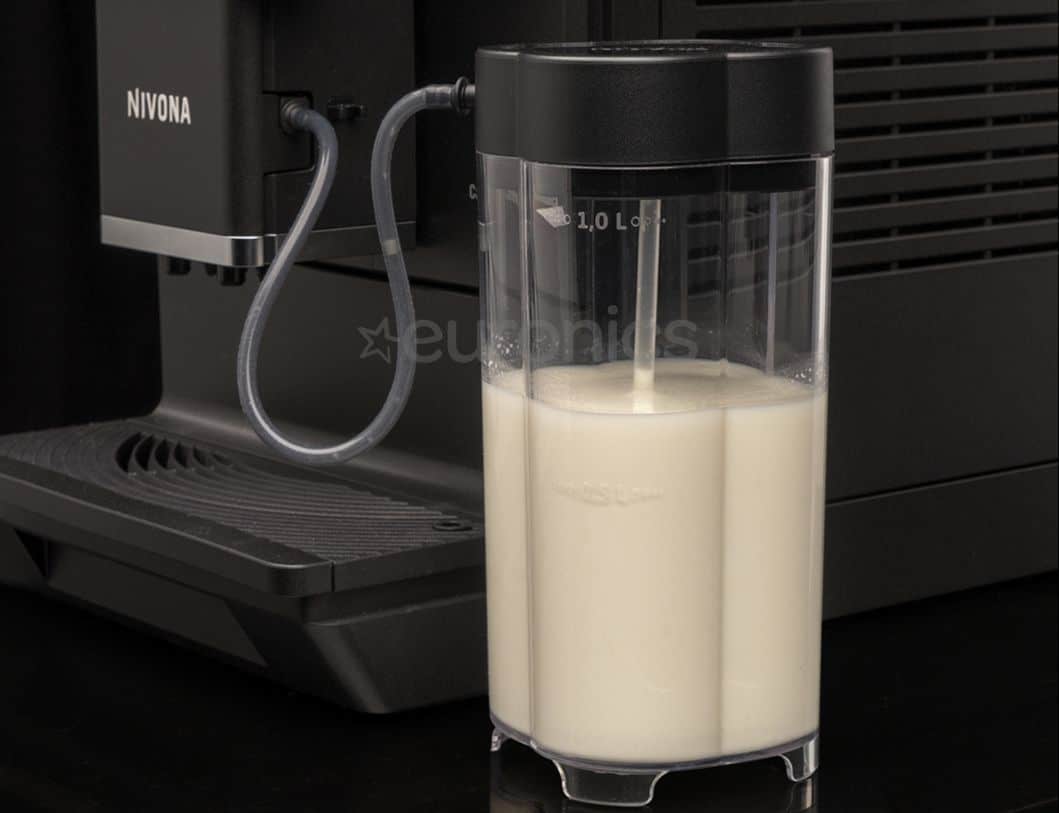
Although most espresso makers come with a milk reservoir for making espresso and other milk-based drinks, it is essential to look out for this feature to be sure. The espresso machine is responsible for not only taking milk from the reservoir, frothing it, and serving it into the cup.
Espresso machines come with different types of milk reservoirs, depending on the brand and model. The machine’s reservoir can either be built-in or freestanding. Here, we will discuss the types of milk reservoirs available to help you make the right buying decision.
Built-In
This is a type of milk reservoir that comes fitted into the machine by the manufacturer. The size of the milk reservoir depends on the manufacture and size of the espresso maker. The downside, however, is that you won’t be able to replace the milk tank with a bigger one.
Free Standing Milk Reservoir
This type of milk reservoir is often purchased separately from the espresso machine. It is available in different sizes and handles the entire process, from sucking the milk to dispensing it into the cup.
Cooling Milk Reservoir
The need to cool milk comes from the fact that it helps preserve the milk and helps keep milk fresh. It is important to buy a removable milk reservoir for easy storage in the fridge when not in use.
FAQ
Final Words
Without a doubt, the taste and flavour of an espresso drink depend on its brewing process. That said, an espresso coffee machine with a grinder helps ensure a smooth brewing process. It also helps to ensure that there is optimum espresso extraction.
If you are looking for an espresso machine with a grinder to buy, our article and guide will help you make the right buying decision. You can make comparisons and choose the best one to suit your needs. We have a wide selection of espresso machines that are convenient, portable and do not take up too much counter space. In addition, they are easy to maintain and clean as well
Notwithstanding, we have selected the Breville BES870XL espresso machine with a grinder as the overall winner as it is suitable for both coffee lovers and anyone willing to give espresso a try. It is a semi-automatic espresso machine equipped with a conical burr grinder, a large water reservoir, a cup warmer, an auto rinse program, and dual boilers that let you brew espresso and cappuccino in a short time.
Additionally, the De’Longhi ESAM3300 Magnifica and Gaggia Brera follow closely with conical burr and ceramic burr grinders. These super-automatic espresso makers offer plenty of customization options, milk frother, automatic turn-off features, and easy cleaning.


